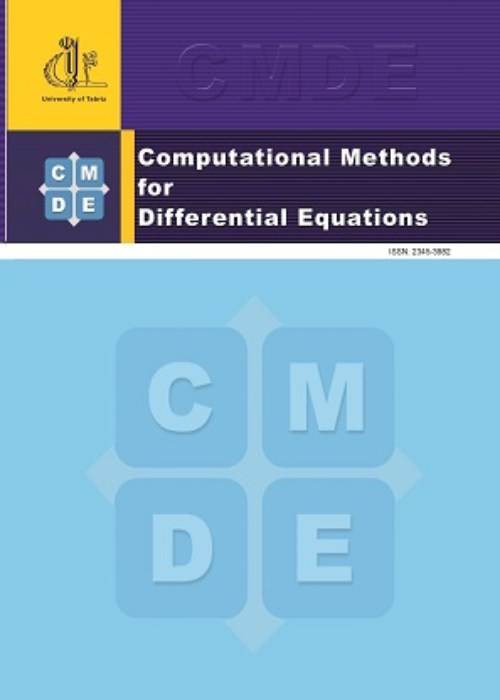فهرست مطالب
Computational Methods for Differential Equations
Volume:5 Issue: 4, Autumn 2017
- تاریخ انتشار: 1396/07/09
- تعداد عناوین: 6
-
-
Pages 256-270In this present study the double layers structure model of extended Korteweg-de Vries(K-dV) equation will be obtained with the help of the reductive perturbation method, which admits a double layer structure in current plasma model. Then by using of new analytical method we obtain the new exact solitary wave solutions of this equation. Double layer is a structure in plasma and consists of two parallel layers with opposite electrical charge.The sheets of charge cause a strong electric field and a correspondingly sharp change in electrical potential across the double layer. As a result, they are expected to be an important process in many different types of space plasmas on Earth and on many astrophysical objects. These nonlinear structures can occur naturally in a variety of space plasmas environment. They are described by the Korteweg-de Vries(K-dV) equation with additional term of cubic nonlinearity in different homogeneous plasma systems. The performance of this method is reliable, simple and gives many new exact solutions. The (G'/G)-expansion method has more advantages: It is direct and concise.Keywords: Double layers, Extended Korteweg-de Vries(KdV), Analytical method
-
Pages 271-279In this paper, at first the elemantary and basic concepts of multiplicative discrete and continous differentian and integration introduced. Then for these kinds of differentiation invariant functions the general solution of discrete and continous multiplicative differential equations will be given. Finaly a vast class of difference equations with variable coefficients and nonlinear difference equations and differential equations are investigated and solved by making use multiplicative difference and differential equationsKeywords: Multiplicative Continuous calculus, Invariant Functions, Multiplicative Discrete calculus
-
Pages 280-300
In this work, the nonlinear boundary value problem in electrohydrodynamics flow of a fluid in an ion-drag configuration in a circular cylindrical conduit is studied numerically. An effective collocation method, which is based on orthonormal Bernstein polynomials is employed to simulate the solution of this model. Some properties of orthonormal Bernstein polynomials are introduced and utilized to narrow down the computation of nonlinear boundary value problem to the solution of algebraic equations. Also, by using the residual correction process, an efficient error estimation is introduced. Graphical and tabular results are presented to investigate the influence of the strength of nonlinearity $alpha$ and Hartmann electric number $Ha^2$ on velocity profiles. The significant merit of this method is that it can yield an appropriate level of accuracy even with large values of $alpha$ and $Ha^2$. Compared with recent works, the numerical experiments in this study show a good agreement with the results obtained by using MATLAB solver bvp5c and its competitive ability.
*The formula is not displayed correctly!
Keywords: Electrohydrodynamics flow, Circular cylindrical conduit, Hartmann electric number, Orthonormal Bernstein polynomials -
Pages 301-309
In this paper, numerical solution of the Benjamin-Bona-Mahony-Burgers (BBMB) equation is obtained by using the mesh-free method based on the collocation method with radial basis functions (RBFs). Stability analysis of the method is discussed. The method is applied to several examples and accuracy of the method is tested in terms of $L_2$ and $L_infty$ error norms.
*The formula is not displayed correctly!
Keywords: Radial basis functions, Mesh-free method, BBMB equation, Stability -
Pages 310-323
The existence of infinitely many weak solutions for a Navier doubly eigenvalue boundary value problem involving the $p(x)$-biharmonic operator is established. In our main result, under an appropriate oscillating behavior of the nonlinearity and suitable assumptions on the variable exponent, a sequence of pairwise distinct solutions is obtained. Furthermore, some applications are pointed out.
*The formula is not displayed correctly!
Keywords: Ricceri's Variational Principle, infinitely many solutions, Navier condition, $p(x)$-biharmonic type operators -
Pages 324-347
Variable-step (VS) second derivative $k$-step $3$-stage Hermite--Birkhoff--Obrechkoff (HBO) methods of order $p=(k+3)$, denoted by HBO$(p)$ are constructed as a combination of linear $k$-step methods of order $(p-2)$ and a second derivative two-step diagonally implicit $3$-stage Hermite--Birkhoff method of order 5 (DIHB5) for solving stiff ordinary differential equations. The main reason for considering this class of formulae is to obtain a set of $k$-step methods which are $L$-stable and are suitable for the integration of stiff differential systems whose Jacobians have some large eigenvalues lying close to the imaginary axis with negative real part. The approach, described in the present paper, allows us to develop $L$-stable $k$-step methods of order up to 10. Selected HBO($p$) of order $p$, $p=9,10$, compare favorably with existing Cash $L$-stable second derivative extended backward differentiation formulae, SDEBDF($p$), $p=7,8$ in solving problems often used to test stiff ODE solvers.
*The formula is not displayed correctly!
Keywords: Hermite--Birkhoff methods, generalized DIRK methods, $A$-stable, oscillatory stiff DETEST problems, confluent Vandermonde-type systems


